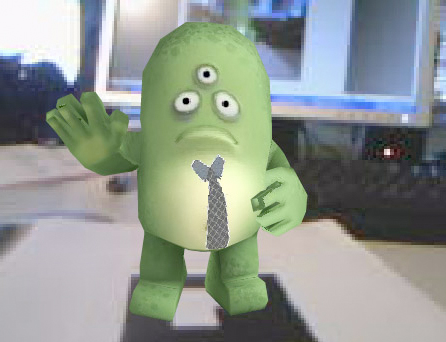Augmented Reality through the appearance of a little green man
 Meet Proto. This little green man appeared on my hand today when I was about to write this blog post. Off course he didn’t ‘just’ appear to me like the virgin Mary. His arrival was caused by an almost magic collaboration between my webcam, Flash, and the use of a symbol printed on ordinairy paper. If you like Proto enough, you can invite him to your home yourself. You only have to download and print this symbol. Then cut it out. Then you just open the Flash-application, click on ‘Start’ en be sure the Flash player has access to the web cam. Then point your web cam at the printed symbol. Proto now will appear on top. You can try moving the symbol and Proto will move with it as in the video below.
Meet Proto. This little green man appeared on my hand today when I was about to write this blog post. Off course he didn’t ‘just’ appear to me like the virgin Mary. His arrival was caused by an almost magic collaboration between my webcam, Flash, and the use of a symbol printed on ordinairy paper. If you like Proto enough, you can invite him to your home yourself. You only have to download and print this symbol. Then cut it out. Then you just open the Flash-application, click on ‘Start’ en be sure the Flash player has access to the web cam. Then point your web cam at the printed symbol. Proto now will appear on top. You can try moving the symbol and Proto will move with it as in the video below.
This way to use augmented reality technique was actually quite new for me. We all know the ways AR is applied in television sports. For instance when we see advertisements projected in a soccer stadium and virtual lines on an ice skating track. Also we got to know Layar, the mobile device application which projects information about our surroundings on the camera display of your mobile phone. In both of these examples I am the spectator and the information is projected in a world I just look at. With Proto, I am still the spectator, but I’m also the objective, together with the augmented green little one.
An Australian creative technology company called Boffswana invented Proto. Boffwana’s lab is the place where Proto is used as a prototype to provoke different kinds of pioneering technical ideas. A visitor of Boffswana’s lab learns that this company loves trying out all those different new techniques. They began in 2008 with building Proto in Papervision, a 3D engine. Soon they made possible for Proto to appear in your home or working place, or on your hand, using AR. The symbol you have to print to make this possible, is called a glyph. Using this glyph, Boffswana releases in may 2009 a new way tot interact with your applications. The printed glyph is now being used as an input control device. Simply put, the people at Boffswana created the ability to control a car via a webcam trough the glyph. The glyph is part of a steering wheel you again have to download, print and cut out. After that, you only have to turn the steer from left to right and the car on your screen does the same. To try it out yourself, you can print out your own steering wheel here and have a go below.
Since I am a graphic designer, the simple use of a symbol that only consists of a printed paper makes me wonder about different ways how to apply this principle in packaging, promotion, publications, infographics and other visualisations. Above mentioned examples have convinced me of the nice to have aspect of this technique, but can we also turn it into a must have? Off course Boffswana wouldn’t be Boffswana if they had not made themselves some sketches how they think they would be able to use this technique in the future. Except for a lot of expected fun ways to apply this technique, like replacing a kids meal toy with 3D and using it in magazines to bring images alive, there are actually also quite a lot of really usefull and meanigfull applications in the list. I myself believe big steps can be made in the field of infographics and instructions. For example: we can turn 2D instructions into 3D animated demonstrations. Or, we can design our own bathroom or kitchen in 3D by using multiple glyps to place the virtual 3D furniture on a 2D plan. Maybe an interesting idea for a company like IKEA?
If we have in mind that the current results of Boffswana’s lab include a Flash based head tracking demonstration in 3D, I really feel we are just at the beginning.
Source: Boffswana.com